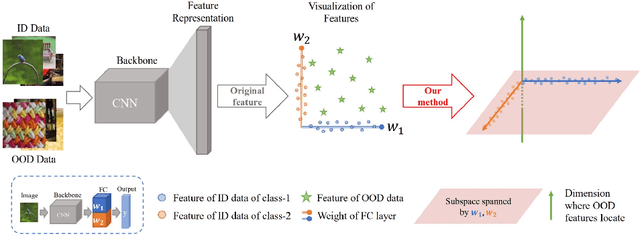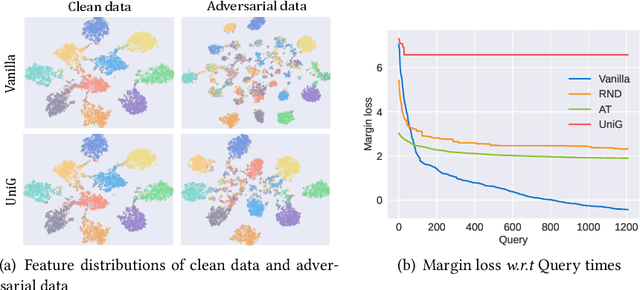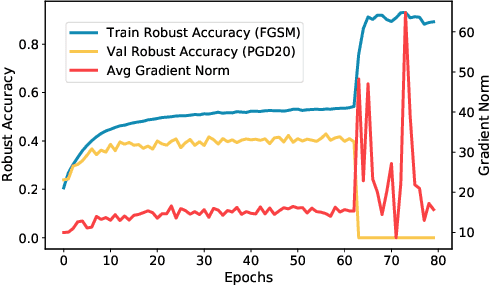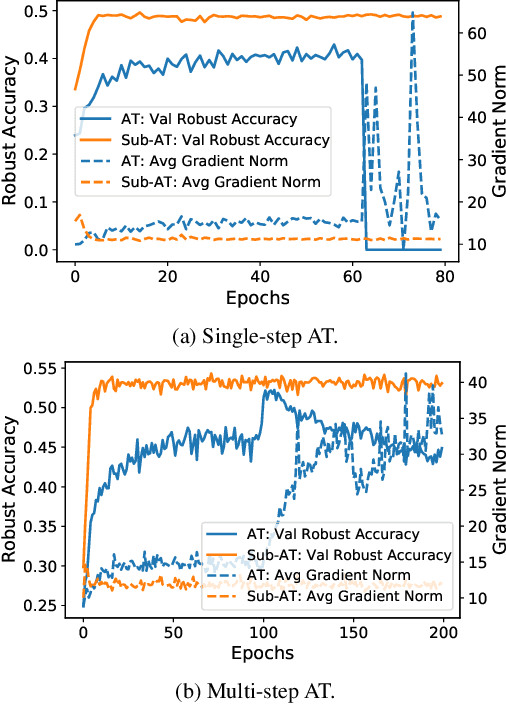Yingwen Wu
Pursuing Feature Separation based on Neural Collapse for Out-of-Distribution Detection
May 28, 2024



Abstract:In the open world, detecting out-of-distribution (OOD) data, whose labels are disjoint with those of in-distribution (ID) samples, is important for reliable deep neural networks (DNNs). To achieve better detection performance, one type of approach proposes to fine-tune the model with auxiliary OOD datasets to amplify the difference between ID and OOD data through a separation loss defined on model outputs. However, none of these studies consider enlarging the feature disparity, which should be more effective compared to outputs. The main difficulty lies in the diversity of OOD samples, which makes it hard to describe their feature distribution, let alone design losses to separate them from ID features. In this paper, we neatly fence off the problem based on an aggregation property of ID features named Neural Collapse (NC). NC means that the penultimate features of ID samples within a class are nearly identical to the last layer weight of the corresponding class. Based on this property, we propose a simple but effective loss called OrthLoss, which binds the features of OOD data in a subspace orthogonal to the principal subspace of ID features formed by NC. In this way, the features of ID and OOD samples are separated by different dimensions. By optimizing the feature separation loss rather than purely enlarging output differences, our detection achieves SOTA performance on CIFAR benchmarks without any additional data augmentation or sampling, demonstrating the importance of feature separation in OOD detection. The code will be published.
Revisiting Random Weight Perturbation for Efficiently Improving Generalization
Mar 30, 2024



Abstract:Improving the generalization ability of modern deep neural networks (DNNs) is a fundamental challenge in machine learning. Two branches of methods have been proposed to seek flat minima and improve generalization: one led by sharpness-aware minimization (SAM) minimizes the worst-case neighborhood loss through adversarial weight perturbation (AWP), and the other minimizes the expected Bayes objective with random weight perturbation (RWP). While RWP offers advantages in computation and is closely linked to AWP on a mathematical basis, its empirical performance has consistently lagged behind that of AWP. In this paper, we revisit the use of RWP for improving generalization and propose improvements from two perspectives: i) the trade-off between generalization and convergence and ii) the random perturbation generation. Through extensive experimental evaluations, we demonstrate that our enhanced RWP methods achieve greater efficiency in enhancing generalization, particularly in large-scale problems, while also offering comparable or even superior performance to SAM. The code is released at https://github.com/nblt/mARWP.
Online Continual Learning via Logit Adjusted Softmax
Nov 11, 2023Abstract:Online continual learning is a challenging problem where models must learn from a non-stationary data stream while avoiding catastrophic forgetting. Inter-class imbalance during training has been identified as a major cause of forgetting, leading to model prediction bias towards recently learned classes. In this paper, we theoretically analyze that inter-class imbalance is entirely attributed to imbalanced class-priors, and the function learned from intra-class intrinsic distributions is the Bayes-optimal classifier. To that end, we present that a simple adjustment of model logits during training can effectively resist prior class bias and pursue the corresponding Bayes-optimum. Our proposed method, Logit Adjusted Softmax, can mitigate the impact of inter-class imbalance not only in class-incremental but also in realistic general setups, with little additional computational cost. We evaluate our approach on various benchmarks and demonstrate significant performance improvements compared to prior arts. For example, our approach improves the best baseline by 4.6% on CIFAR10.
Low-Dimensional Gradient Helps Out-of-Distribution Detection
Oct 26, 2023



Abstract:Detecting out-of-distribution (OOD) samples is essential for ensuring the reliability of deep neural networks (DNNs) in real-world scenarios. While previous research has predominantly investigated the disparity between in-distribution (ID) and OOD data through forward information analysis, the discrepancy in parameter gradients during the backward process of DNNs has received insufficient attention. Existing studies on gradient disparities mainly focus on the utilization of gradient norms, neglecting the wealth of information embedded in gradient directions. To bridge this gap, in this paper, we conduct a comprehensive investigation into leveraging the entirety of gradient information for OOD detection. The primary challenge arises from the high dimensionality of gradients due to the large number of network parameters. To solve this problem, we propose performing linear dimension reduction on the gradient using a designated subspace that comprises principal components. This innovative technique enables us to obtain a low-dimensional representation of the gradient with minimal information loss. Subsequently, by integrating the reduced gradient with various existing detection score functions, our approach demonstrates superior performance across a wide range of detection tasks. For instance, on the ImageNet benchmark, our method achieves an average reduction of 11.15% in the false positive rate at 95% recall (FPR95) compared to the current state-of-the-art approach. The code would be released.
Efficient Generalization Improvement Guided by Random Weight Perturbation
Nov 21, 2022



Abstract:To fully uncover the great potential of deep neural networks (DNNs), various learning algorithms have been developed to improve the model's generalization ability. Recently, sharpness-aware minimization (SAM) establishes a generic scheme for generalization improvements by minimizing the sharpness measure within a small neighborhood and achieves state-of-the-art performance. However, SAM requires two consecutive gradient evaluations for solving the min-max problem and inevitably doubles the training time. In this paper, we resort to filter-wise random weight perturbations (RWP) to decouple the nested gradients in SAM. Different from the small adversarial perturbations in SAM, RWP is softer and allows a much larger magnitude of perturbations. Specifically, we jointly optimize the loss function with random perturbations and the original loss function: the former guides the network towards a wider flat region while the latter helps recover the necessary local information. These two loss terms are complementary to each other and mutually independent. Hence, the corresponding gradients can be efficiently computed in parallel, enabling nearly the same training speed as regular training. As a result, we achieve very competitive performance on CIFAR and remarkably better performance on ImageNet (e.g. $\mathbf{ +1.1\%}$) compared with SAM, but always require half of the training time. The code is released at https://github.com/nblt/RWP.
On Multi-head Ensemble of Smoothed Classifiers for Certified Robustness
Nov 20, 2022Abstract:Randomized Smoothing (RS) is a promising technique for certified robustness, and recently in RS the ensemble of multiple deep neural networks (DNNs) has shown state-of-the-art performances. However, such an ensemble brings heavy computation burdens in both training and certification, and yet under-exploits individual DNNs and their mutual effects, as the communication between these classifiers is commonly ignored in optimization. In this work, starting from a single DNN, we augment the network with multiple heads, each of which pertains a classifier for the ensemble. A novel training strategy, namely Self-PAced Circular-TEaching (SPACTE), is proposed accordingly. SPACTE enables a circular communication flow among those augmented heads, i.e., each head teaches its neighbor with the self-paced learning using smoothed losses, which are specifically designed in relation to certified robustness. The deployed multi-head structure and the circular-teaching scheme of SPACTE jointly contribute to diversify and enhance the classifiers in augmented heads for ensemble, leading to even stronger certified robustness than ensembling multiple DNNs (effectiveness) at the cost of much less computational expenses (efficiency), verified by extensive experiments and discussions.
Unifying Gradients to Improve Real-world Robustness for Deep Networks
Aug 12, 2022



Abstract:The wide application of deep neural networks (DNNs) demands an increasing amount of attention to their real-world robustness, i.e., whether a DNN resists black-box adversarial attacks, among them score-based query attacks (SQAs) are the most threatening ones because of their practicalities and effectiveness: the attackers only need dozens of queries on model outputs to seriously hurt a victim network. Defending against SQAs requires a slight but artful variation of outputs due to the service purpose for users, who share the same output information with attackers. In this paper, we propose a real-world defense, called Unifying Gradients (UniG), to unify gradients of different data so that attackers could only probe a much weaker attack direction that is similar for different samples. Since such universal attack perturbations have been validated as less aggressive than the input-specific perturbations, UniG protects real-world DNNs by indicating attackers a twisted and less informative attack direction. To enhance UniG's practical significance in real-world applications, we implement it as a Hadamard product module that is computationally-efficient and readily plugged into any model. According to extensive experiments on 5 SQAs and 4 defense baselines, UniG significantly improves real-world robustness without hurting clean accuracy on CIFAR10 and ImageNet. For instance, UniG maintains a CIFAR-10 model of 77.80% accuracy under 2500-query Square attack while the state-of-the-art adversarially-trained model only has 67.34% on CIFAR10. Simultaneously, UniG greatly surpasses all compared baselines in clean accuracy and the modification degree of outputs. The code would be released.
Trainable Weight Averaging for Fast Convergence and Better Generalization
May 26, 2022



Abstract:Stochastic gradient descent (SGD) and its variants are commonly considered as the de-facto methods to train deep neural networks (DNNs). While recent improvements to SGD mainly focus on the descent algorithm itself, few works pay attention to utilizing the historical solutions -- as an iterative method, SGD has actually gone through substantial explorations before its final convergence. Recently, an interesting attempt is stochastic weight averaging (SWA), which significantly improves the generalization by simply averaging the solutions at the tail stage of training. In this paper, we propose to optimize the averaging coefficients, leading to our Trainable Weight Averaging (TWA), essentially a novel training method in a reduced subspace spanned by historical solutions. TWA is quite efficient and has good generalization capability as the degree of freedom for training is small. It largely reduces the estimation error from SWA, making it not only further improve the SWA solutions but also take full advantage of the solutions generated in the head of training where SWA fails. In the extensive numerical experiments, (i) TWA achieves consistent improvements over SWA with less sensitivity to learning rate; (ii) applying TWA in the head stage of training largely speeds up the convergence, resulting in over 40% time saving on CIFAR and 30% on ImageNet with improved generalization compared with regular training. The code is released at https://github.com/nblt/TWA.
Adversarial Attack on Attackers: Post-Process to Mitigate Black-Box Score-Based Query Attacks
May 24, 2022



Abstract:The score-based query attacks (SQAs) pose practical threats to deep neural networks by crafting adversarial perturbations within dozens of queries, only using the model's output scores. Nonetheless, we note that if the loss trend of the outputs is slightly perturbed, SQAs could be easily misled and thereby become much less effective. Following this idea, we propose a novel defense, namely Adversarial Attack on Attackers (AAA), to confound SQAs towards incorrect attack directions by slightly modifying the output logits. In this way, (1) SQAs are prevented regardless of the model's worst-case robustness; (2) the original model predictions are hardly changed, i.e., no degradation on clean accuracy; (3) the calibration of confidence scores can be improved simultaneously. Extensive experiments are provided to verify the above advantages. For example, by setting $\ell_\infty=8/255$ on CIFAR-10, our proposed AAA helps WideResNet-28 secure $80.59\%$ accuracy under Square attack ($2500$ queries), while the best prior defense (i.e., adversarial training) only attains $67.44\%$. Since AAA attacks SQA's general greedy strategy, such advantages of AAA over 8 defenses can be consistently observed on 8 CIFAR-10/ImageNet models under 6 SQAs, using different attack targets and bounds. Moreover, AAA calibrates better without hurting the accuracy. Our code would be released.
Subspace Adversarial Training
Nov 24, 2021



Abstract:Single-step adversarial training (AT) has received wide attention as it proved to be both efficient and robust. However, a serious problem of catastrophic overfitting exists, i.e., the robust accuracy against projected gradient descent (PGD) attack suddenly drops to $0\%$ during the training. In this paper, we understand this problem from a novel perspective of optimization and firstly reveal the close link between the fast-growing gradient of each sample and overfitting, which can also be applied to understand the robust overfitting phenomenon in multi-step AT. To control the growth of the gradient during the training, we propose a new AT method, subspace adversarial training (Sub-AT), which constrains the AT in a carefully extracted subspace. It successfully resolves both two kinds of overfitting and hence significantly boosts the robustness. In subspace, we also allow single-step AT with larger steps and larger radius, which further improves the robustness performance. As a result, we achieve the state-of-the-art single-step AT performance: our pure single-step AT can reach over $\mathbf{51}\%$ robust accuracy against strong PGD-50 attack with radius $8/255$ on CIFAR-10, even surpassing the standard multi-step PGD-10 AT with huge computational advantages. The code is released$\footnote{\url{https://github.com/nblt/Sub-AT}}$.
 Add to Chrome
Add to Chrome Add to Firefox
Add to Firefox Add to Edge
Add to Edge